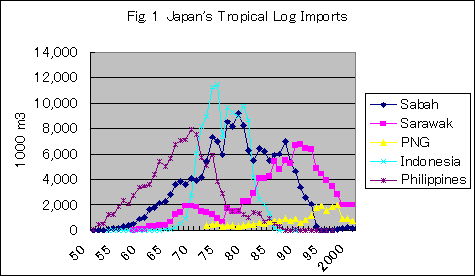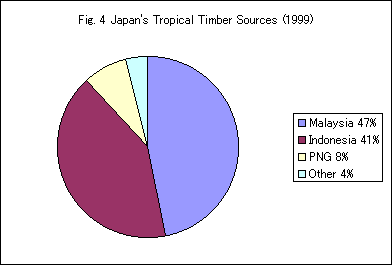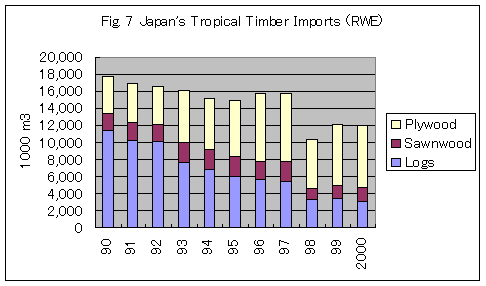
Japan's Tropical Timber Imports-An Overview
(Excerpt from "Current State of Tropical Forests in 2001-Case Studies from Indonesia and Malaysia," Japan Tropical Forest Action Network)
The History of Japan's Tropical Timber Imports
Japan has a long history of tropical timber imports. It was from the Philippines that Japan first imported tropical timber, starting in the 1950's and peaking in the second half of the 1960's. Depletion of forest resources led to a subsequent decline in exports, and a total ban on log exports in 1986. As a result of excessive logging, the Philippines lost most of its forest cover and became a net importer of timber.
Indonesia and the Malaysian state of Sabah became the next major sources. Indonesia became the number one source of tropical timber imports to Japan in the 1970's. However, the Indonesian government began to restrict log exports around 1980, and totally banned them in 1985, in order to promote domestic plywood production. Since then, plywood imports from Indonesia have increased dramatically, putting pressure on the Japanese plywood industry.

Source: Japan Lumber Importers Association
Imports from Sarawak state, Malaysia, increased as the Indonesian government began to restrict log exports around 1980. Around 90% of tropical timber imported to Japan was from the states of Sabah and Sarawak in the late 1980's. At this time when attention was being focused on the tropical rainforest issue worldwide, Japan faced criticism for its role in rainforest destruction as the world's number one importer of tropical timber. Sabah banned log exports in 1993 due to forest resource depletion, and imports of logs from Sarawak declined during the 1990's, but Sarawak continues to be the primary source of tropical logs to Japan. Log imports from Papua New Guinea and plywood imports from Malaysia increased in the 1990's.
In this way, Japan has shifted its timber sources each time the forest resources have been depleted in the supplying region. Furthermore,while log imports decreased, plywood imports from Indonesia and Malaysia increased during the 1990's, such that plywood imports exceeded Japanese domestic plywood production from 1996 and thereafter.

Source: Customs Clearance Statistics, Ministry of Finance
Japan still the World's Number One Importer of Tropical Timber
Since Japan's tropical log imports declined in the 1990's, the world's number one importer of tropical logs is now China. However, Japan's tropical plywood imports increased in the 1990's so that they now account for 44% of worldwide tropical plywood trade. If Japan's total tropical timber imports are calculated in terms of roundwood equivalents, they account for 25% (1999) of global trade, so Japan is still the world's leading importer of tropical timber.

Source: Prepared from gITTO Annual Review.h Total imports of logs, sawnwood, plywood, etc., in round-wood equivalents.

Source: Prepared from gTrade Statistics.h Total imports of logs, sawnwood, plywood, etc., in round-wood equivalents.
The main sources of tropical timber imported to Japan in 1999 were Malaysia (logs, plywood, sawnwood) followed by Indonesia (plywood, sawnwood),and Papua New Guinea (logs). Conversely, the main destination of timber exports from Malaysia and Indonesia was Japan. Logging in Malaysia and Indonesia continues to have major environmental and social impact.

Source: gITTO Annual Reviewh

Source: Prepared from gITTO Annual Review.h Total exports of logs, sawnwood, plywood, etc., in round-wood equivalents.
Further Efforts to Reduce Consumption are Needed
Concern for tropical forest destruction and Japan's role in it increased in Japan from the end of the 1980's, and the mass media also began to report on the tropical forest issue as one of the global environmental issues, especially after the so-called Earth Summit held in Rio de Janeiro in 1992. From 1990 and on, rainforest protection organizations were formed in various places in Japan, and began to lobby local governments to reduce use of tropical timber panels for molding concrete in public works. The construction industry, which was under criticism for its wasteful practices, established a voluntary plan in 1992 for 16 major companies to "reduce the use of tropical timber panels for molding concrete by 35% in 5 years." (The result was a 24.3% reduction)
However, despite efforts in various fields, there was hardly any reduction in tropical timber consumption from 1990 through 1997. It was in 1998 that there was the first major reduction in tropical timber consumption. An economic downturn with bankruptcies of major banks and securities firms caused housing starts and overall demand for timber to drop significantly. Though consumption has dropped due to the impact of the economy in general, it is extremely unfortunate that efforts to reduce timber consumption out of concern for environmental and social issues in the producer countries have achieved hardly any results. Japan's responsibility as the number one importer of tropical timber is heavy indeed. It is crucial that all concerned parties accelerate their efforts to reduce tropical timber consumption.

Source: Prepared from Customs Clearance Statistics, Ministry of Finance. Logs, sawnwood, and plywood in round-wood equivalents.